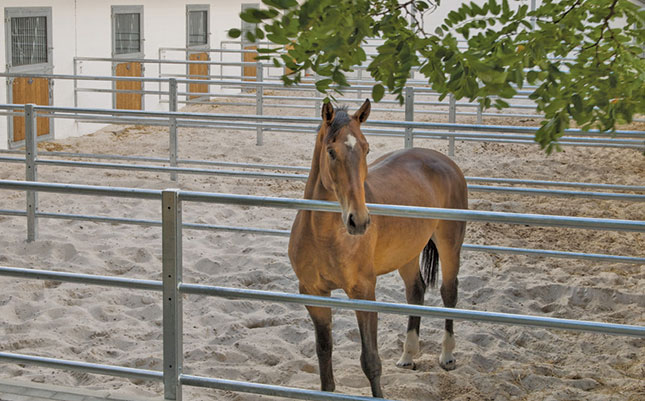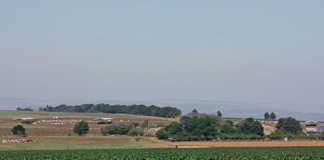
Photo: Wikimedia Commons
Due to the COVID-19 lockdown, veterinarians have generally become more willing to assist horse owners in assembling a first-aid kit for emergency use at home or during horse shows.
The kit has three components. The first comprises medications that need to be refrigerated. Keep these together in a plastic container, and transport them to shows in a cooler bag with plastic ice blocks.
The second component is made up of wound dressings, bandages, sprays and ointments. You can also include a number of homeopathic remedies, which only need to be kept cool, not refrigerated.
Finally, you will need a selection of syringes and needles, as well as plastic gloves, which should easily fit into a small toolbox. A twitch and a set of basic farrier tools may also come in handy.
Refrigerated medications
Some veterinarians allow clients to keep injectable colic medications that need to be refrigerated. This is because a horse with acute colic can injure itself badly by rolling frantically in the stable, and cannot be taken to a veterinary hospital. However, insurance will not cover a horse that the owner treats with a registered drug, so always phone the vet for permission.
In addition, certain medications, such as vitamin B12, Buscopan and penicillin, cannot be used in competition horses ridden under the rules of the International Federation for Equestrian Sports.
It is also a good idea to keep a dose of tetanus vaccine, which you can use as a booster if there is a puncture wound, especially around the hoof.
Non-refrigerated medications
Eye powders, wound sprays, ointments and homeopathic medications need to be kept cool, but not refrigerated, so can easily be packed together. Arnica Ice, for example, can be used to treat bumps, sprains and bruises. Epsom salts is useful for poultices or soaking hooves, and two tablespoons a day in drinking water will reduce the risk of impaction colic at a show.
Pack a set of four stable bandages per horse, as they can be used for travelling as well as first aid. Include cotton wool, sterile wound dressings, four 10cm gauze bandages, four 10cm self-adhesive bandages (Vetrap) and a roll of sticky plaster (Elastoplast), as they are all essential for treating open wounds. Wound ointments, such as acriflavine and glycerine, or Germolene, are also useful.
Add a bottle of sterile saline for washing out wounds, or cleaning eyes and nostrils. Eye powders containing tetracycline can also be used as wound powders; they are available over the counter at veterinary shops.
Other essentials for the kit are homeopathic remedies such as Eco-Fear, Eco-Travel and Eco-Colic. A bottle of gamma-irradiated honey is useful, too, as a few tablespoons with water can be given orally for shock, and honey is a good treatment for superficial wounds.
You can even apply a handful of cane sugar to a bleeding wound before putting on a pressure bandage.
Instruments and implements
Include two pairs of scissors (one for cutting bandages and one for cutting away hair around wounds), as well as a stethoscope. If your horse has a resting heart rate of over 60 beats/minute or a respiration rate higher than 25 breaths/minute, this is cause for alarm. A digital thermometer is also essential. The normal rectal temperature of a horse is 38,2°C; if its 40°C or higher, contact a vet urgently.
Preventing Colic
Colic remains the leading cause of death in horses, and is a common problem for many horse owners. The term ‘colic’ is non-specific, and refers to abdominal pain. Fortunately, most colic episodes can be treated successfully with minimal intervention; in severe cases, however, surgery may be necessary (see page 83). Unfortunately, these surgeries can be prohibitively expensive, particularly if the horse is not insured.
Colic can be caused by a variety of factors, including compaction and a build-up of gas. In some cases, no root cause can be determined. A horse’s distended gut may twist around itself if the animal begins to roll when experiencing colic. If the twist in the intestine is not corrected, part of it may die.
Signs and symptoms of colic may include:
- The horse frequently looks at its side, bites or kicks its flank or belly, lies down and/or rolls.
- It has few or no bowel movements. The faecal balls may be smaller than usual.
- It passes dry or mucus-covered manure.
- The animal feeds poorly and there is a change in drinking behaviour.
- Its heart rate may be more than 50 beats/minute.
- It has tacky gums.
- Its mucous membranes are off-colour.
Colic is best prevented by making sure that your horse has a balanced diet and
gets an adequate amount of exercise. Poor diets and inadequate mobility are known to cause colic. You should also ensure that the animal has ad lib access to fresh, clean water.
Make sure that your horse’s teeth are well maintained, which will enable it to chew its feed properly, and that its deworming routine is up to date.
Should your horse exhibit any symptoms of colic, take action immediately. This may involve leading the horse around a paddock or lunge arena to stimulate movement in the bowel. It is also important to lead the horse out of a small, enclosed area, as rolling here might lead to injury. If you have Buscopan available, administer it.
Nasogastric tubes could also be used by a veterinarian or someone skilled in the practice. If the colic persists or the horse rolls and thrashes uncontrollably, call your veterinarian immediately.
Treating hoof abscesses
Hoof abscesses are a common problem in horses, and can result in severe lameness if not treated in good time. An abscess usually starts as localised pain, and may not be visible until later.
It occurs when the hoof sole is punctured, and bacteria or other pathogens enter the hoof. It may be difficult to detect at first, and the only sign may be lameness, the severity of which will depend on the horse. Lameness can be mild to severe.
Other signs and symptoms of hoof abscesses include the following:
- Swelling;
- Heat at the site;
- Drainage of pus from the sole or coronary band;
- Increased pulse; and
- A black spot on the sole or sole-wall junction where a crack or puncture is contaminated with dirt.
According to Dr Rual Bras of the Rood & Riddle Equine Hospital in Kentucky in the US, treatment starts with cleaning the foot, and “softening the hoof capsule via foot soaks and poultices to encourage rupture/drainage, and keeping the foot wrapped and protected from further debris entering and causing further infection”.
He adds: “Anti-inflammatory medication and antibiotics may also be given if needed. After drainage is obtained, progressive improvement should be expected on a daily basis.”
Limiting the horse’s movement may also help improve lameness. If the abscess doesn’t heal on its own after a few days, consult your veterinarian.
Source: horse.com
Taking temperature
Taking your horse’s temperature is important to determine if it is sick, or if an illness or other affliction is brewing. The temperature must be taken rectally. Thanks to the invention of digital thermometers, the process has become much easier.
Before taking the horse’s temperature, have a groom or friend hold its head. Stand beside the horse (not behind it), and slightly lift its tail to the side. Insert the tip of the thermometer a couple of centimetres into the rectum; a lubricant shouldn’t be necessary.
Make sure that you keep hold of the thermometer, or it may disappear entirely!
Once the thermometer beeps, remove it and read the results. It’s important that your horse’s temperature be taken daily to establish a baseline. In this way, you’ll know whether there is a drastic change in the temperature, which may appear normal in terms of the average, and you can act within reason to prevent or treat any illness.











